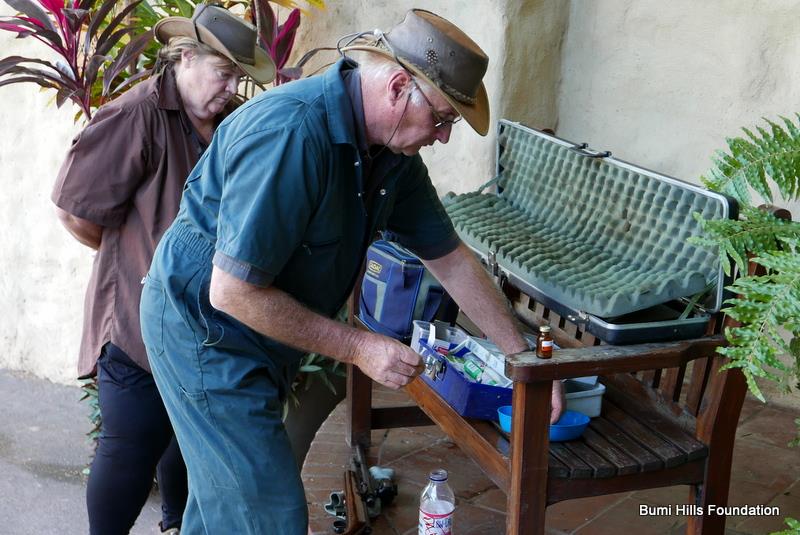On Saturday morning, staff at a Bumi Hills lodge in Zimbabwe were surprised to discover that an elephant bull had arrived outside one of the staff houses with a severe limp. Upon closer inspection, they suspected that the wounded elephant had been the victim of a failed poaching attempt. He had two bullet holes through his left ear and a septic wound on his left shoulder.

Estimated to be at least 30 years old, the bull had made his way up the steep escarpment to the lodge during the night despite the painful-looking wound on his shoulder. The wounded elephant was clearly quite dehydrated as he readily drank the three buckets of water we gave him and had not moved away from the house for nearly five hours. Perhaps the elephant knew that we could help.
Staff quickly arranged for a wildlife vet to fly in to the lodge that afternoon, dart him and give him the necessary life-saving treatment. Six hours later, when the vet arrived, the elephant hadn’t moved further than a few metres.
Seeing his wounds, Dr. Richard Hoare quickly went to work preparing to dart and treat the animal.

The dart went into his rear rump perfectly, and he only moved off a short distance in the seven minutes before he went down. He also landed perfectly on his haunches with his right side up a slope, the perfect position considering we needed to work on his left side.
Once darted, the whole treatment took a little over an hour, in which the vet and workers managed to clean and disinfect his wound, check for any remnants of a bullet and administer antibiotics to the wounded elephant.


The nature and cause of the wound has left everyone puzzled. It is a large entry hole, approximately 4cm in diameter, perfectly round and smooth and extends approximately 10cm downwards into his shoulder joint, and there are no other wounds visible on the animal at all. The wound was approximately a month old, but again, this is difficult to tell exactly.
The nature of the wound suggests that if caused by a bullet, it was fired from an elevated position down onto the animal, not a commonly used method of shooting an animal, but with our rugged terrain, it is quite possible. We will arrange for a mobile X-ray unit to be brought in if he requires follow-up treatment, which will hopefully give us a better idea of what happened.


Once the operation was completed and the drugs had worn off, he was back up on his feet within five minutes before rushing off into some thick cover.

The team also fitted Ben, named after the staff member who found him, with a VHF tracking collar so that we can monitor him closely over the next two weeks when we will dart him again to carry out a follow-up check and hopefully remove his collar.

We are still unsure of the extent of the internal damage this animal has sustained at this stage but, having treated the wound, we have hopefully minimised the risk of serious infection and got him out of immediate danger. It is incredibly humbling how everyone just pulls together when an animal needs urgent medical attention, and we are extremely grateful to all those who helped out.
Yesterday, the elephant spent most of the morning in fairly open bush,veld and the photo below was taken of him, albeit at long range.

When the above photo was taken, the wounded elephant was not limping as badly, and the wound seemed to be healing well externally. His condition remains good, and he is feeding normally. These are all positive signs; however, there is still a very long road ahead for this elephant, considering we still do not know the extent of the internal injuries he may have, but we will be keeping a close eye on him to determine if any further treatment is needed.
From data collected in aerial surveys carried out over Zimbabwe in 2001 and again in 2013, there has been an estimated decrease in elephant numbers of 75% in the Sebungwe area, which basically stretches the length of Lake Kariba and includes inland areas such as Matusadona and Chizarira National Parks. These worrying statistics have resulted in the formation of the Bumi Hills Foundation in March 2016. The foundation will focus predominantly on community development initiatives within the local community, including healthcare, education and economic empowerment, while continuing to carry out vital conservation work through the newly incorporated BHAPU.
UPDATE 23 June 2016:
Based on the improvement in his condition and mobility over the past two weeks and the state of the wound now, the overall prognosis is that Ben has an extremely good chance of fully recovering, albeit over a couple of months.
To comment on this story: Login (or sign up) to our app here - it's a troll-free safe place 🙂.![]()







